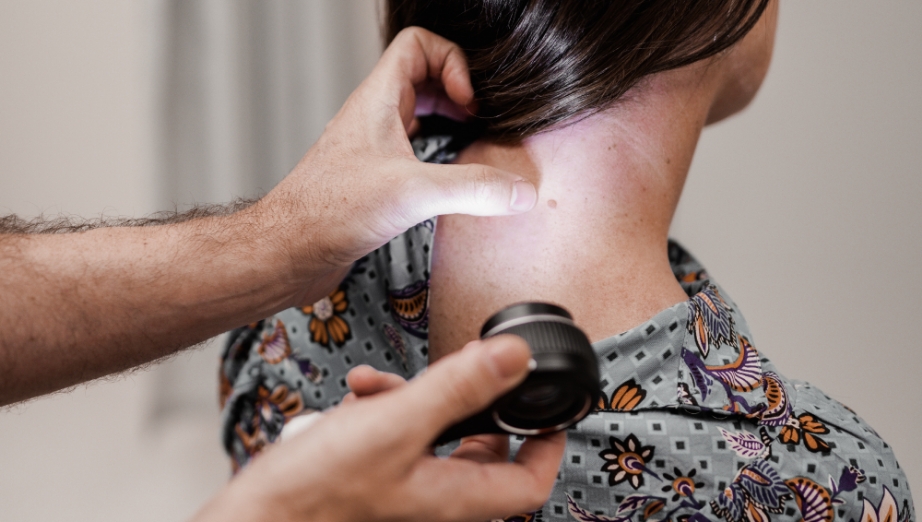What is a mole?
A mole describes a variety of skin imperfections, sometimes referred to as a beauty mark. They are usually tan, brown, reddish-brown, black, red, purple, or skin-coloured and can be flat or raised. Some moles can become darker and more visible with prolonged sun exposure and pregnancy. They can occur anywhere on the skin, but the number of moles a person has varies based on genetics and the amount of sun exposure. Regular moles are harmless, benign, and symmetrical in size and appearance. Irregular or atypical moles are asymmetrical and misshapen with multiple colours, most commonly appearing on sun-exposed skin. The appearance of more than 20 irregular moles can increase a person’s risk of developing melanoma.
Mole removal for cosmetic reasons is quite common. You may have a mole that catches or rubs on clothes, causing discomfort, or the mole may be unsightly and in a prominent location. In these cases, cosmetic mole removal using techniques that give the best aesthetic result is the best course of action.
Cancerous moles are known as melanomas and are usually asymmetrical. It is very rare for regular moles to evolve into melanomas, but it is important to check all known moles regularly for any changes. Patients should have a skin check, especially if any changes have occurred with a mole. If the doctor believes the mole is problematic or risky, it is removed via biopsy and tested for cancerous cells. At Shellharbour Skin, we perform skin checks and biopsies for individuals wanting to get their skin checked or for skin cancer patients. For more information, please visit our Skin Checks and Skin Cancer pages.
Benefits of mole removal
- Safeguarding your health — Mole removal decreases your chance of skin cancer by removing suspicious-looking moles and examining them. It is a great preventative measure in detecting precancerous moles.
- Enhance your self-esteem and boost your confidence — Some patients may have benign moles in highly-visible areas, such as the face, which can be challenging to hide. Removing apparent skin lesions can restore your confidence and create a more desired appearance.
- Improve your quality of life — In some cases, larger moles can irritate the skin, causing discomfort, inhibiting shaving, and even becoming infected. Removal of the mole will eliminate these issues, contributing to a healthier, happier life.

Mole removal consultation at Shellharbour Skin
During your consultation at our clinic, moles, skin lesions, and other kinds of spots are checked to see if they fit the “ABCDE” criteria for detecting any potentially cancerous skin lesions. However, the process is slightly different for patients wanting a benign mole removed for cosmetic reasons. You will need to discuss your medical history, including any family history of skin cancer or if you have had any previous melanomas. Our doctors then assess the mole and surrounding area to create a treatment plan that is right for you. Removal techniques depend on the size and shape of the benign mole and its location. Therefore, it is essential to evaluate this before undergoing any removal. If you have concerns, the consultation is where you can discuss this, as you will be given information on what to expect before, during, and after your removal procedure.
What to expect
There are various treatment options available for mole removal, which come with their own side effects and risks. Some techniques may be better suited than others but differ for every patient.
Treatment options for mole removal
- Excision: An excision aims to cut out the entire mole, which is usually necessary for cancerous moles. A small amount of local anaesthetic is applied around the mole and cut out, including some surrounding tissue. A few stitches are needed to close the wound, meaning that there will be a small scar which should fade with time, but every patient’s body reacts differently to scarring. Recovery time can be a few days to a couple of weeks, depending on the size of the mole and its location.
- Punch biopsy: This technique is designed for tiny moles and is a less invasive method of removing the entire mole. A small amount of anaesthetic is applied locally around the mole before a special tool is used to remove a small portion of skin from the target area. Because of how small the diameter of the removal area is, stitches are often not required, meaning there is a very minimal risk of scarring.
- Shaving: Some moles may be shaved down with a particular instrument, the aim of the technique being to remove only the top layer of a mole that is raised above the surface of the skin. This technique also requires local anaesthetic, but the depth of the incision will depend on the patient’s circumstances. No stitches are needed in most cases, meaning there is minimal scarring risk.
- Radiofrequency: This technique uses high-frequency radio wavelengths channelled through an electrode tip to cut through the skin. Radiofrequency is also used to shave off raised, benign moles. However, there is far less bleeding, scarring, or swelling, and the wound heals much faster. No stitches are required, meaning the minimal chance of scarring, and can be used to remove moles on any part of the body.
- Cryotherapy: Cryotherapy is a technique using extremely cold liquid nitrogen to remove unwanted skin lesions, essentially freezing off the mole and destroying its cells.The cells inside the mole are destroyed and gradually scab over, falling off in the weeks after your procedure. This is a common removal technique for warts, skin tags, blood spots, sun spots, moles, and other skin lesions.
Recovery & aftercare for mole removal
Recovery and aftercare following mole removal are vital. They are different for every patient based on the location and size of the mole and what type of removal technique patients undergo. Generally, the surgical site is dressed with a water-absorbing bandage, allowing patients to shower while wearing the gauze. This dressing will need to be changed every three days.
If you have had a mole removed around your facial area, your sutures are removed after one week. For mole removal on all other body areas, you will have the sutures removed after two weeks. During this time, you should avoid swimming and any physical activity that could disrupt the sutures.
If your removal method is via excision, you may apply scar gel after removing the sutures to minimise potential scarring. For the other removal techniques, you may apply scar gel several days after your procedure.
Following your mole removal, you may need to follow a suncare plan to prevent any sun damage from occurring on your skin and potentially turning a mole cancerous. You can incorporate simple steps into your routine, such as wearing a hat when outside, using a daily sunscreen of SPF 30 or higher, and wearing UV-protective sunglasses are effective methods to protect your skin against the sun’s harsh rays.
Risks & complications
Risks and complications are associated with any procedure you choose to undergo, whether medical or cosmetic, and it is crucial that you are aware of them before proceeding. There are specific side effects associated with each removal method, and you will be informed of this during your consultation based on your treatment plan. General risks and complications of mole removal include:
- Redness
- Infection
- Skin discolouration
- Soreness
- Minor scarring
If you have a question, get in touch and one of our staff will be in touch shortly.




